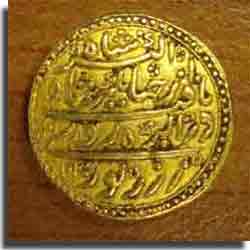History :
In fifteenth century the political condition of India deteriorated and there was no powerful kingdom in northern India to rule. The last ruling Lodi dynasty had weakened the position. Such a situation invited the invasion from northern west boarders of India with Babur's Invasion.
Zahiruddun Mohammed Babur founded the Mughal Emphire in India; he is the history's most powerful conquerors. In his young days he was among the improvised princes, all descended by Timur. He inherited the small state of Farghana in AD 1494. In order to extend in India and improve his situation in central Asia he invaded India five times. In the fifth expedition he defeated Ibrahim Lodi at Panipat in AD 1526. Babur's conquest was incomplete till he defeated Rana Sanga, the kind of Mewar and the greatest Rajput kind of the period.
Rana Sanga was defeated on 16 March, 1527 but unfortunately Babur was not destined to enjoy the fruits of his victory as he died in Agra in AD 1530. Babur was an enlightened ruler who loved poetry, gardening and books. He wrote cultural treatises on Hindus, he conquered and took notes on flora and fauna. Babur's eldest son Humayun succeeded him as the king. The strongest challenge for Humayun was the Afghan Leader Sher Shah Suri, who defeated Humayun in the battles of Chausa and Kanuaj in AD 1540. Humayun was forced to spend nearly fifteen year in exile in Persia. The Shah of Iran gave him shelter in Persia.

Place |
Delhi, Punjab, Kashmir, Kaveri, Bengal. |
Period |
1526 to 1858 or 16th to 18th century |
Language |
Urdu, Persian, Arabic and Turkic. |
Rulers |
Babur, Humayun, Akbar, Jahangir, Shah Jahan, Aurangzeb, |
Religion |
Sunni Islam, Din-i-llahi |
During this period Sher Shah family ruled the over Northern India. Though Sher Shah ruled only for short period he is remembered in Indian History as one of the best rulers in Medieval India. In AD 1554 Humayun was able to invade India with the help of Bairam Khan. He conquered most of the Punjab and defeated the Afghans in a battle near Sirhind and captured Delhi. When Humayun died he left behind his thirteen year old son Jalal-ud din Akbar as his heir under the care of Bairam Khan.
Akbar had demonstrated his own capacity as an Administrator. He was free from influences of the ministers of his court. He had shown his capability for judgement and leadership. His administrative policies were backbone of Mughal Empire for more than 200 years. He separated the military and political functions from the other functions of the Imperial Service. Akbar created a ranked Imperial service based on the person's ability rather than birth. In the second battle of Panipat fought between Hemu Vikramaditya and Bairam Khan in AD 1556, Hemu was defeated. It gave Delhi and Agra back to Akbar. In 1562 he married a Rajput princess, daughter of the Raja of Amber (now Jaipur). She becomes one of his senior wives and the mother of his heir, Jahangir.


Languages Spoken
Language spoken by the Mughals was Urdu which slowly evolved into a mixture of to a form of Hindustani known as Urdu. Apart from Urduthe other languages spoken were Persian, Arabic and Turkic.
Mughal Coinage

This coin weighed 178 grains. It remained largely unchanged till the early 20th Century. Gold coins were issued together with the silver Rupiya and they were called the 'Mohur' which weighed 169 grains. The copper coins were called the 'Dam'.
Usage of Coins by Mughal reflected originality and innovative in technique. The designs of coins came to development during the reign of the Grand Mughal emperor, Akbar.


